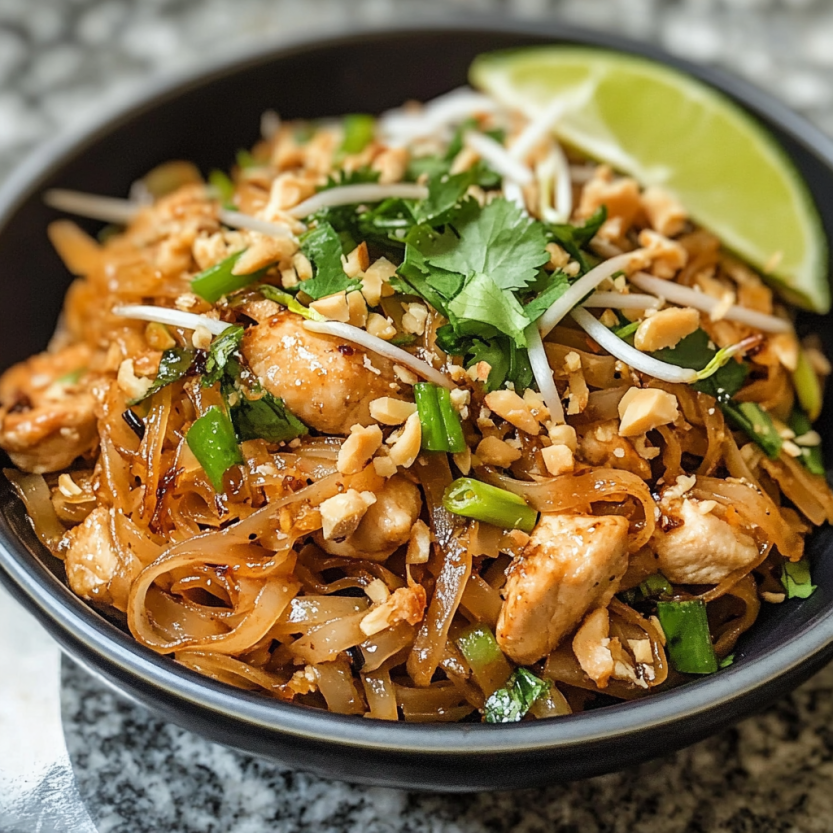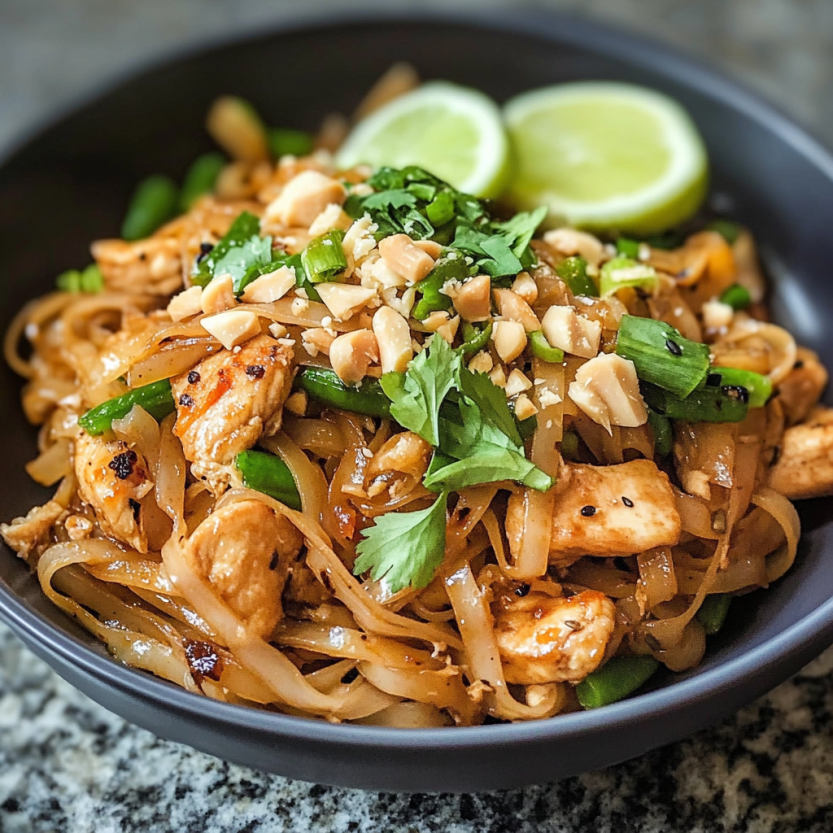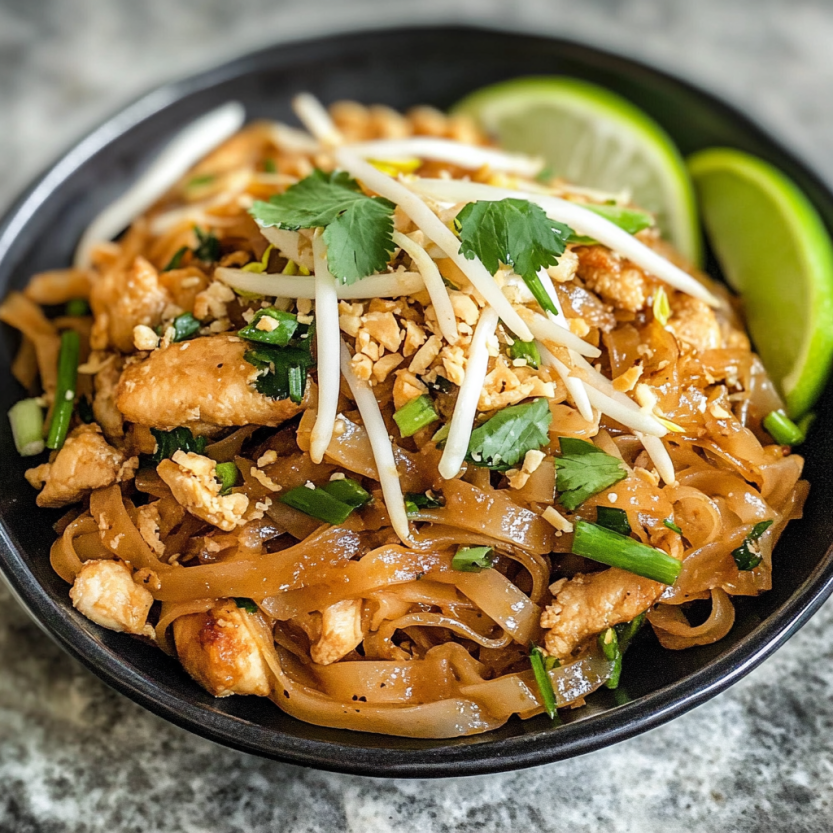 Save
Save
This authentic chicken Pad Thai recipe transforms a takeout favorite into a homemade masterpiece in just 25 minutes. The perfect balance of sweet, savory, sour, and nutty flavors creates restaurant-quality results with minimal effort.
I first made this recipe after an impulsive midnight craving for Thai food when all restaurants were closed. Now it has become our Sunday tradition when my family gathers around the table to share stories from the week.
Ingredients
- Rice stick noodles: creates the authentic base for this dish and provides the perfect chewy texture
- Fish sauce: delivers that essential umami flavor that defines real Pad Thai
- Fresh lime juice: adds brightness and balances the savory elements
- Soy sauce: enhances the overall depth without overpowering
- Sriracha sauce: allows you to control the heat level according to your preference
- Brown sugar: provides that signature Thai sweetness that caramelizes beautifully
- Chicken thigh meat: stays tender and juicy even with quick cooking
- Fresh garlic: infuses aromatic complexity throughout the dish
- Eggs: create silky richness and bind the ingredients together
- Firm tofu: adds protein and absorbs the flavorful sauce
- Fresh chives: bring a mild onion flavor and beautiful color contrast
- Bean sprouts: provide essential crunch and freshness
- Chopped peanuts: deliver the traditional nutty finish and textural contrast
Step-by-Step Instructions
- Make the Sauce:
- Combine fish sauce, lime juice, soy sauce, sriracha, and brown sugar in a small bowl and stir thoroughly until sugar dissolves completely. The sauce should have a balance of tangy, sweet and savory notes. Set aside to allow flavors to meld while you prep other ingredients.
- Prepare the Noodles:
- Soak dry rice noodles in room temperature water for exactly 10 minutes until they become pliable but still firm to the touch. They should bend without breaking but still have resistance. Drain thoroughly and set aside. Properly soaked noodles will finish cooking in the pan without becoming mushy.
- Cook the Protein Base:
- Heat vegetable oil in a large wok or pan over medium high heat until shimmering. Add diced chicken and minced garlic, spreading them evenly across the pan surface. Cook for 3 minutes, stirring frequently until chicken is just cooked through with slight browning. The garlic should be fragrant but not burned.
- Add Noodles and Eggs:
- Add drained noodles to the pan and stir continuously for one full minute to coat them with the oil and flavors. Push noodles to one side creating an empty space in the pan. Crack eggs directly into this space and scramble quickly until they form small curds with no visible liquid remaining. Immediately integrate the cooked eggs into the noodles using a folding motion to distribute them evenly.
- Combine with Sauce and Finish:
- Pour the prepared sauce over the noodle mixture and stir vigorously to ensure even coating. Turn heat down to low and add tofu, chives and bean sprouts. Continue stirring gently for another minute until everything is well incorporated and noodles have absorbed most of the sauce. The noodles should appear glossy and have changed from translucent to more opaque.
- Garnish and Serve:
- Sprinkle chopped peanuts evenly over the top of the finished Pad Thai. Transfer immediately to serving plates while still hot. Garnish with additional lime wedges and bean sprouts on the side if desired for personalized adjustments to flavor and texture.
 Save
Save
The fish sauce is truly the secret ingredient here. When I first started making Pad Thai, I was tempted to skip it due to its strong aroma, but discovered it creates that distinctive Thai restaurant flavor that cannot be replicated. My husband now requests this dish weekly, always asking if I remembered the fish sauce.
Make It Your Own
This Pad Thai recipe welcomes customization based on your preferences and what you have available. Swap chicken for shrimp by adding them at the same stage but cooking for only 1-2 minutes until pink. For vegetarian options, omit the chicken and double the tofu or add mushrooms for umami depth. The basic sauce and cooking technique remain the same regardless of protein choice.
Time-Saving Tips
Prep is essential for Pad Thai success as the cooking happens very quickly. Measure all sauce ingredients before starting and have all vegetables chopped and ready. For even quicker preparation, use pre-minced garlic and rotisserie chicken. Having everything within arm's reach makes the cooking process smooth and prevents overcooking any components.
The Perfect Texture
The most challenging aspect of homemade Pad Thai is achieving the right noodle texture. Soaking rather than boiling the noodles gives you more control. They should still have a slight firmness when added to the pan as they will continue cooking with the sauce. If noodles become too soft during soaking, rinse under cold water to stop the process. The finished dish should have noodles that are tender but still slightly chewy.
 Save
Save
Recipe Questions
- → Can I use rotisserie chicken in Pad Thai?
Yes, you can substitute with ½ to 1 cup shredded rotisserie chicken. Add it directly with the noodles and continue the recipe as written, skipping the chicken cooking step since it's already cooked.
- → How do I prevent the noodles from becoming mushy?
Cook the Pad Thai just until the sauce dries and the noodles change from transparent to white. They should remain firm, not mushy. If you're new to stir-frying noodles, try reducing the heat slightly as the cooking process moves quickly.
- → What's the best way to prepare for making Pad Thai?
Have all ingredients prepped and within arm's reach before you begin. The cooking process is fast, and proper preparation ensures everything goes smoothly. Pre-measure ingredients and have them ready in small bowls.
- → Why do I need to continuously stir while cooking Pad Thai?
Continuous stirring ensures even heat distribution and cooking of all ingredients. Using two spatulas can help mix everything evenly and quickly, preventing any ingredients from burning or cooking unevenly.
- → How should I serve Chicken Pad Thai?
Serve immediately while hot. Once the noodles cool, they begin losing texture and flavor. Consider serving with extra bean sprouts and lime wedges on the side for added freshness and allowing diners to adjust flavors to taste.
- → Can I make this dish less spicy?
Yes, simply reduce or omit the sriracha sauce in the recipe. The dish will still maintain its authentic flavor profile from the fish sauce, lime juice, and soy sauce while being milder.